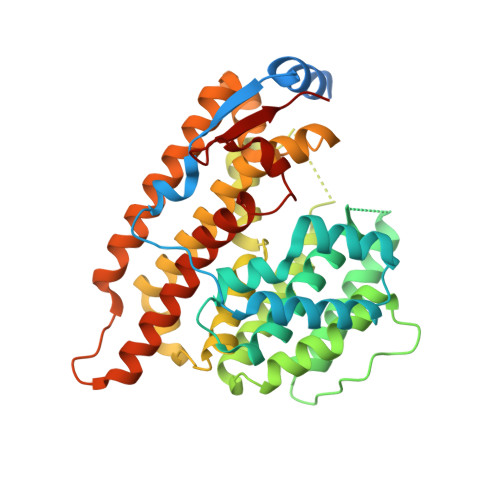Structural insights into the cyclization of unusual brasilane-type sesquiterpenes.
Wang, T., Yang, Y., He, M., Liu, M., Huang, J.W., Min, J., Chen, C.C., Liu, Y., Zhang, L., Guo, R.T.(2022) Int J Biol Macromol 209: 1784-1791
- PubMed: 35504416
- DOI: https://doi.org/10.1016/j.ijbiomac.2022.04.150
- Primary Citation of Related Structures:
7W5F, 7W5G, 7W5H, 7W5I, 7W5J - PubMed Abstract:
The biosynthesis of brasilane-type sesquiterpenoids (BTSs) attracts much attention owing to their unique skeleton of 5/6 bicyclic structure that contains five Me groups. Here, the crystal structures of a BTS cyclase TaTC6 from Trichoderma atroviride FKI-3849 and its complexes with farnesyl pyrophosphate (FPP) and analogue were reported. These structural information reveal that TaTC6 exploits a hydrophobic pocket to constrain the hydrocarbon region of FPP in a "U-shape" to facilitate the initial C1-C11 bond formation after pyrophosphate ionization. Following, four carbocations of reaction intermediates were molecularly docked into the hydrophobic pocket to reveal critical residues involved in the cyclization cascade. Finally, an S239-stabilized water molecule that is 3.9 Å away from the C8 of the last allyl cation may conduct hydration to quench the reaction cascade. Mutating S239 to alanine led to ca. 40% reduction in activity compared with the wild-type enzyme. The conservation of the residues that constitute the hydrophobic pocket is also discussed. Overall, this study will give an insight into the mechanism of how the active site of STCs constrain the conformation of the flexible FPP and series allylic carbocations for the complicated-ring formation and unusual carbon rearrangement in the biosynthesis of BTSs.
- State Key Laboratory of Biocatalysis and Enzyme Engineering, Hubei Hongshan Laboratory, Hubei Collaborative Innovation Center for Green Transformation of Bio-Resources, Hubei Key Laboratory of Industrial Biotechnology, School of Life Sciences, Hubei University, Wuhan 430062, PR China.
Organizational Affiliation:

















